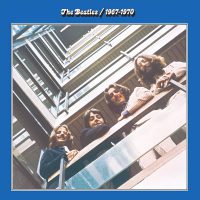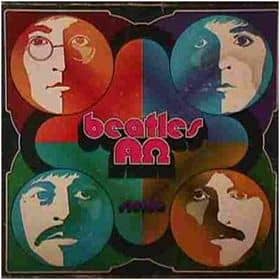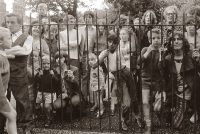
Producer: George Martin
Released: 19 April 1973 (UK), 2 April 1973 (US)
Tracklisting
‘Strawberry Fields Forever’
‘Penny Lane’
‘Sgt Pepper’s Lonely Hearts Club Band’/‘With A Little Help From My Friends’
Lucy In the Sky With Diamonds
‘Within You Without You’*
‘A Day In The Life’
‘All You Need Is Love’
‘I Am The Walrus’
‘Hello, Goodbye’
‘The Fool On The Hill’
‘Magical Mystery Tour’
‘Lady Madonna’
‘Hey Jude’
‘Revolution’
‘Dear Prudence’*
‘While My Guitar Gently Weeps’
‘Ob-La-Di, Ob-La-Da’
‘Glass Onion’*
‘Blackbird’*
‘Hey Bulldog’*
‘Get Back’
‘Don’t Let Me Down’
‘The Ballad Of John And Yoko’
‘Old Brown Shoe’
‘Here Comes The Sun’
‘Come Together’
‘Something’
‘Octopus’s Garden’
‘Oh! Darling’*
‘I Want You (She’s So Heavy)’*
‘Let It Be’
‘Across The Universe’
‘I Me Mine’*
‘The Long And Winding Road’
‘Now And Then’*
* 2023 reissue
First released in 1973, the so-called Blue Album brought together 28 highlights from The Beatles’ back catalogue, from their 1967 single ‘Penny Lane’/‘Strawberry Fields Forever’ to ‘Let It Be’.
Like its red counterpart, The Beatles 1962-1966, the Blue Album was brought to production swiftly as a response to an illegal two-volume, 120-song bootleg titled Alpha Omega which had been issued earlier in 1973.
Alpha Omega had contained songs from The Beatles’ back catalogue, along with several songs from their solo careers. The set was marketed by a New Jersey company called Audio Tape Inc, and sold only via TV mail order. Apple quickly shut down the production and distribution of Alpha Omega, and brought out their own compilations.
Allen Klein drew up a list of songs to include on the Red and Blue albums, and offered to give the former Beatles the chance to veto the selection. Unlike 1962-1966, the Blue Album contained songs written by George Harrison and Ringo Starr, as well as those by John Lennon and Paul McCartney.
I didn’t want lousy versions going out, I wanted them to be as was. And I asked Capitol/EMI, or EMI/Capitol whichever, please ask George Martin would he take care of this, so at least he knows what to do. I didn’t want some strange guy, you know, making dubbed versions of it and putting it out, because of the versions that were going out [on other compilations] the reissues were pretty poor. I hadn’t even listened to them, because I just presumed they’d take the tape as we made it and make a master and put it out again, but they didn’t, they’d been screwing around with a few of the early ones. I didn’t know that until it was too late. So on that last package where they had Beatles 60… different periods – that one. I made sure. The Red and The Blue, that one. I made sure George Martin was there and I made sure they put that picture which I got Linda [sic] to take of the same pose as their very first album over the Abbey Road… No what is it that… EMI office in some other place, some square? Manchester Square. So I was involved in that respect, in that package making sure that the cover was what I wanted and that the sound was done by George Martin. So I don’t mind that one. Checked the remix after he’d done it, it was as good as you could get out of whatever mono recording we did then.
The Lennon Tapes, Andy Peebles
Cover artwork
The front cover of 1967-1970 featured a photograph of The Beatles taken in 1969. Originally intended to adorn the unreleased Get Back LP, which was repackaged as Let It Be in 1970, the shot featured the group recreating their pose on the cover of their debut UK album, Please Please Me.
The photographs were taken as The Beatles looked down from the stairwell at EMI House, the label’s headquarters in Manchester Square, London. An outtake from the Please Please Me shoot was used on the rear of the Blue Album, and on the front of the Red Album.
The gatefold covers of both albums featured a photograph of The Beatles and fans taken during the ‘Mad Day Out’ in London on 28 July 1968.
International variations
Unlike the 1962-1966 collection, the Blue Album was largely the same in the US and UK, although there were some variations. The US edition had both ‘Penny Lane’ and ‘Hello, Goodbye’ in mono, and ‘I Am The Walrus’ with a four-beat electric piano introduction; the UK version had the more common six-bar beginning.
The albums had several other variants and anomalies. ‘Get Back’ was described as the album version in the US liner notes, although it was in fact the single version.
In both countries, ‘Hey Jude’ was around nine seconds shorter than it had been on the original single, although the full length was restored for the 1993 compact disc edition.
The original vinyl version faded in during the crowd noise at the beginning of ‘A Day In The Life’. The original compact disc edition, meanwhile, featured a clean version previously heard on the Imagine: John Lennon soundtrack album in 1988.
Chart success
The Beatles 1967-1970 was released in the United States on 2 April 1973, simultaneously with the 1962-1966 album. Its original retail price was $9.98, which was considerably higher than the conventional price of $5.98 for a single album.
Despite criticism in some quarters, however, the Blue Album topped the Billboard chart, and has since sold more than 8 million copies.
In the United Kingdom it was issued on 19 April 1973, and reached number two on the charts.
Remastered versions of The Beatles 1962-1966 and 1967-1970 were both released worldwide on 18 October 2010 (the following day in North America). The remastering was done by the same team led by Allan Rouse which had remastered The Beatles’ entire back catalogue for 2009.
The reissues were both double-CD sets, and included expanded booklets with new essays written by Bill Flanagan, and rare photographs of The Beatles.
2023 reissues
The 1967-1970 compilation and its 1962-1966 counterpart were reissued on 10 November 2023.
The albums were expanded and remixed in stereo and Dolby Atmos. The Red album contained an additional 12 songs across two CDs or three vinyl discs: ‘I Saw Her Standing There’, ‘Twist And Shout’, ‘This Boy’, ‘Roll Over Beethoven’, ‘You Really Got A Hold On Me’, ‘You Can’t Do That’, ‘If I Needed Someone’, ‘Taxman’, ‘Got To Get You Into My Life’, ‘I’m Only Sleeping’, ‘Here, There And Everywhere’, and ‘Tomorrow Never Knows’.
The Blue album contained nine more songs across two CDs and three vinyl discs: ‘Within You Without You’, ‘Dear Prudence’, ‘Glass Onion’, ‘Blackbird’, ‘Hey Bulldog’, ‘Oh! Darling’, ‘I Want You (She’s So Heavy)’, ‘I Me Mine’, and ‘Now And Then’.
The albums were also issued in 4xCD and 6xLP slipcase sets. The Beatles’ official store had exclusive red and blue vinyl editions.








I bet Alpha Omega is worth a lot now.
Apparently copies turn up on eBay now and then. I don’t think it’s worth masses – $20-30 perhaps, which isn’t bad for 120 Beatles songs.
Yeah, I would’ve thought so too; 15 songs per LP is pretty good. But apparently the whole thing was mastered from scratchy vinyl, so that’s no good. Anyways, the cover’s pretty cool.
I still can’t believe the bootleggers behind this release had the nerve to advertise something so obviously illegal on TV!
This wasn’t the only one. ROOTS was another.
That’s not the same dude
Hi Skye….You would have thought so! and another thought…my 120+ bootlegs would all be worth MUCH more in 2021 LOL most of my first issue boots on vinyl , stuff like; 20×4, Sessions, Sweet Apple Trax Vol 1-3 et al in VG condition (mint too me means never played!) are about what I paid for them, or maybe a little more… but not much…..OMG all the trips into NYC and the village in the 1970’s/80’s/90’s to peruse and buy some of the latest boots, hoping to meet John :)…or Pellet records (Long live Mal!) in Morristown NJ in the 1980’s/90’s. no value increase in my bootlegs all these years later…but you know? I would never change a thing cause I was grooving to the Decca gone sessions or Johnny & the moon dogs live in Sweden (Perhaps my favorite bootleg of all time! quality was superb for 1979) all long before the anthology’s in 1995/96.
Just for fun, I made a playlist that mimics the song order of Alpha Omega: the sequencing is absolutely terrible. It seems as though they started just putting the songs in alphabetical order, but that system broke down fairly quickly.
There was a second four-LP set released at the same time, with even worse sequencing: groups of tracks from various US albums, along with a half a dozen solo songs from singles albums that had appeared by the end of 1972–All Things, Ram, and Imagine.
The versions used in the original LPs, too, were the US Capitol releases, with the notorious Dave Dexter stereo remixes. But obviously, they didn’t use the original tapes, so you’re getting LP dubs in a haphazard sequence. The Red and Blue albums may not have dug as deeply into the Beatles’ catalogue, but at least the ordering makes sense, and the sound is impeccable. I still have my old vinyl copies on Apple!
The Bootleggers were scums who most likely didn’t give a crap about getting busted
I have this album and theres a problem with it: the side 2 of the second LP is not the right one. The songs on it are the songs of the side 2 of the second LP of the “red album“. On the sticker we can read the list of the songs that should be on this LP… Does it worth something?
Capitol SKBO 3404
This is not how Beatles songs are meant to be enjoyed. So much is missing. Songs on the released albums generally flow together like a quilt tapestry that result in a complete and unique sound. This LP is OK for casual listeners and radio DJs from the 70’s who need to access “the hits”.
its very convenient to have when you already own all the beatles released albums, but cant get ahold of the singles.
When I grew up, my parents always used to listen to the red and blue albums, so the sequence of the songs on them are stuck in my head forever, and they do sound “right” to me, whereas the original albums have a bit of weirdness for me as my brain expects different songs to follow the ones included on red and blue.
I prefer the lists of us albums rather than original… they are more catchy…. Just I think…
How much is an original album of this worth?
i have two photos from what i believe to be the last remaining test shots from the blue album from angus mcbean , i purchased them from auction a few years back when his partner sold off the entire collection ,, i am thinking of selling them and this place is prob the best place to start before i i think about putting them back into auction
Hey Simon! Do you still have these test shots? I’d love to hear the story of how you came across them.
On the Remastered version of the blue album from 2009 on the inner sleeve photos done by Don McMullen it says St Pancras old church it say 22 July 1969 which it clearly is not! I’m told it was July 1968 which looking at it and pics from that era it most definitely is July 1968
I’ll put this out there from 1964 in NEw Zealand, I worked as a typewriter & Stenacord dictating machine techno. Met the Beatles when my Brother BRUCE came into work to see me as he had Telegramms to deliver to the Beatles who were Staying at the Royal International Hotel on Victoria Street West . Opposite where I worked.Went across with him as in those days they had to sign for their Telegrams before they were given them , They All came out and signed for them an they asked if we were going to the concert but we said we couldn’t afford to & they gave us 2 Tickets each, for the concert, wow wow what a night, Great lot of guys couldn’t say enough about them. When back to work an Photo copyed it on a liquid copier in those days , Dryed it gave him the copy an gave the original when I got home , he lost it when he Shifted from Hamilton, NZ. In 1974, would be worth heaps now. But that’s Life.
Thanks for the story. Reminds me of a record I have by the Beatles… “Bruce” is written on the label and its from New Zealand, coincidence or not?
this was and still is my favorite album from beatles. its an awesome mix and my favorite songs from them are on it. i would recommend to anyone who like the beatles.